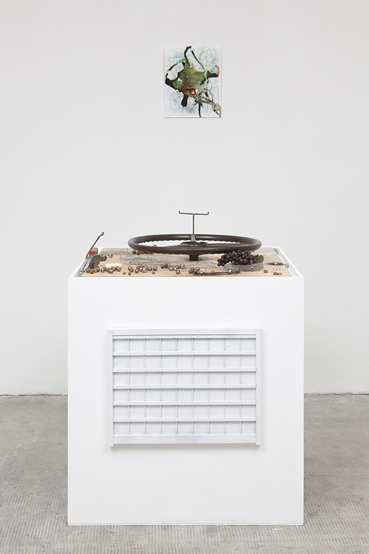
© » KADIST
José Castrellón
Palo Enceba’o is a project by José Castrellón composed of three photographs, two drawings on metal, and a video work that creates a visual and cultural analogy between the events of January 9th, 1964 in Panama City and the game of palo encebado carried out in certain parts of Panama to celebrate the (US-backed) independence from Colombia. In the game, young men climb a wood post smeared with animal wax to collect a Panamanian flag in return for a bounty. During what is now remembered as Martyrs’ Day, Panamanian students trespassed the fence that separated the American-governed strip of land along the Panama Canal and Panama City to fly a flag and symbolically claim sovereignty over the area that had been turned over to the United States by the Hay–Bunau-Varilla Treaty in 1903.

© » KADIST
José Castrellón
Palo Enceba’o is a project by José Castrellón composed of three photographs, two drawings on metal, and a video work that creates a visual and cultural analogy between the events of January 9th, 1964 in Panama City and the game of palo encebado carried out in certain parts of Panama to celebrate the (US-backed) independence from Colombia. In the game, young men climb a wood post smeared with animal wax to collect a Panamanian flag in return for a bounty. During what is now remembered as Martyrs’ Day, Panamanian students trespassed the fence that separated the American-governed strip of land along the Panama Canal and Panama City to fly a flag and symbolically claim sovereignty over the area that had been turned over to the United States by the Hay–Bunau-Varilla Treaty in 1903.

© » KADIST
José Castrellón
Palo Enceba’o is a project by José Castrellón composed of three photographs, two drawings on metal, and a video work that creates a visual and cultural analogy between the events of January 9th, 1964 in Panama City and the game of palo encebado carried out in certain parts of Panama to celebrate the (US-backed) independence from Colombia. In the game, young men climb a wood post smeared with animal wax to collect a Panamanian flag in return for a bounty. During what is now remembered as Martyrs’ Day, Panamanian students trespassed the fence that separated the American-governed strip of land along the Panama Canal and Panama City to fly a flag and symbolically claim sovereignty over the area that had been turned over to the United States by the Hay–Bunau-Varilla Treaty in 1903.

© » KADIST
Uri Aran
Like much of Aran’s work this sculptural installation is akin to a riddle. It has no exact meaning, and it can be somewhat frustrating, yet with careful inspection it begins to reveal unexpected information. In his 2014 exhibition at Peep-Hole, Milan, where this work was shown, Aran referred in a series of new works to Mancala games.

© » KADIST
Erbossyn Meldibekov
Game (Six Pieces) by Erbossyn Meldibekov is inspired by the popular Rubik’s cube puzzle and is composed of three colors (red, green and white) instead of six, referencing the colors of the Afghan flag. The work provides a revisionist interpretation of the legacy of The Great Game (the original 19th-century standoff between Russian and British empires over Afghanistan), and Afghanistan’s position as a centerpiece of the longstanding War on Terror, (the military campaign led by the United States and their allies against organizations and regimes they identified as terrorists after 9/11). Game (Six Pieces) mobilizes dark humor and irony to illustrate the complex and unstable relationships between communism, Islam, and American and British imperialism.

© » KADIST
Taus Makhacheva
For Taus Makhacheva, the wild, untamed side of human nature is often the foundation of many of her formal investigations. A leading voice of the younger generation based in Moscow, Makhacheva works with sculpture and installation while her preferred medium remains video. Her Dagestani (Northern Caucasian) roots draw her to this rugged land as her site of choice for many of her works.
Uri Aran
Born in 1977 in Jerusalem Lives and works in New York...
Erbossyn Meldibekov
Through drawing, installation, painting, photography, and video, Erbossyn Meldibekov’s practice examines architecture, monumentality, and value systems in the public domain...
Taus Makhacheva
Taus Makhacheva’s performance and video works critically examine what happens when different cultures, traditions come into contact with one another...
